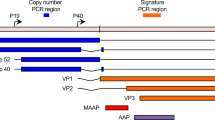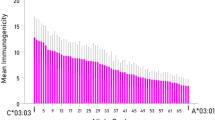Abstract
Simian virus 40 (SV40) is a DNA tumor virus known to induce cancers in laboratory animals. There are numerous reports of the detection of SV40 DNA and/or proteins in human malignancies of the same types as those induced by SV40 in animals, including brain cancers. However, known exposure to the virus has not yet been linked directly to cancer development in a specific individual. Here we describe the detection of SV40 sequences in the meningioma of a laboratory researcher who had a probable direct exposure to SV40 and subsequently developed a tumor positive for viral DNA sequences indistinguishable from those of the laboratory source. This case suggests a link between viral exposure and tumor development.
This is a preview of subscription content, access via your institution
Access options
Subscribe to this journal
Receive 50 print issues and online access
$259.00 per year
only $5.18 per issue
Buy this article
- Purchase on Springer Link
- Instant access to full article PDF
Prices may be subject to local taxes which are calculated during checkout




Similar content being viewed by others
Abbreviations
- CSF:
-
cerebral spinal fluid
- PCR:
-
polymerase chain reaction
- SV40:
-
simian virus 40
References
Arrington AS and Butel JS . (2001). Human Polyomaviruses: Molecular and Clinical Perspectives, Khalili K and Stoner GL (ed). John Wiley & Sons: New York, pp. 461–489.
Arrington AS, Lednicky JA and Butel JS . (2000). Anticancer Res., 20, 879–884.
Bocchetta M, Di Resta I, Powers A, Fresco R, Tosolini A, Testa JR, Pass HI, Rizzo P and Carbone M . (2000). Proc. Natl. Acad. Sci. USA, 97, 10214–10219.
Brinster RL, Chen HY, Messing A, Van Dyke T, Levine AJ and Palmiter RD . (1984). Cell, 37, 367–379.
Butel JS . (2000). Carcinogenesis, 21, 405–426.
Butel JS, Arrington AS, Wong C, Lednicky JA and Finegold MJ . (1999). J. Infect. Dis., 180, 884–887.
Butel JS and Lednicky JA . (1999). J. Natl. Cancer Inst., 91, 119–134.
Butel JS and Ozbun MA . (1994). Methods in Molecular Genetics. Vol. 4: Molecular Virology Techniques, Part A, Adolph KW (ed). Academic Press: San Diego, pp. 282–309.
David H, Mendoza S, Konishi T and Miller CW . (2001). Cancer Lett., 162, 57–64.
Eddy BE, Borman GS, Grubbs GE and Young RD . (1962). Virology, 17, 65–75.
Evans AS and Mueller NE . (1990). Ann. Epidemiol., 1, 71–92.
Gazdar AF, Butel JS and Carbone M . (2002). Nat. Rev. Cancer, 2, 957–964.
Gerber P and Kirschstein RL . (1962). Virology, 18, 582–588.
Gish WR and Botchan MR . (1987). J. Virol., 61, 2864–2876.
Griffiths DJ, Nicholson AG and Weiss RA . (1998). Dev. Biol. Stand., 94, 127–136.
Huang KC, Yamasaki EF and Snapka RM . (1999). Virology, 262, 457–469.
Hwang SP and Kucherlapati R . (1980). Virology, 105, 196–204.
Ilyinskii PO, Daniel MD, Horvath CJ and Desrosiers RC . (1992). J. Virol., 66, 6353–6360.
Jasani B, Cristaudo A, Emri SA, Gazdar AF, Gibbs A, Krynska B, Miller C, Mutti L, Radu C, Tognon M and Procopio A . (2001). Semin. Cancer Biol., 11, 49–61.
Krieg P and Scherer G . (1984). Virology, 138, 336–340.
Lednicky JA, Arrington AS, Stewart AR, Dai XM, Wong C, Jafar S, Murphey-Corb M and Butel JS . (1998). J. Virol., 72, 3980–3990.
Lednicky JA and Butel JS . (1997). J. Gen. Virol., 78, 1697–1705.
Lednicky JA and Butel JS . (2001). Semin. Cancer Biol., 11, 39–47.
Lednicky JA, Garcea RL, Bergsagel DJ and Butel JS . (1995). Virology, 212, 710–717.
Lednicky JA, Stewart AR, Jenkins III JJ, Finegold MJ and Butel JS . (1997). Int. J. Cancer, 72, 791–800.
Li RM, Branton MH, Tanawattanacharoen S, Falk RA, Jennette JC and Kopp JB . (2002). J. Am. Soc. Nephrol., 13, 2320–2330.
Ling PD, Lednicky JA, Keitel WA, Poston DG, White ZS, Peng RS, Liu Z, Mehta SK, Pierson DL, Rooney CM, Vilchez RA, Smith EO and Butel JS . (2003). J. Infect. Dis., 187, 1571–1580.
Martini F, Lazzarin L, Iaccheri L, Vignocchi B, Finocchiaro G, Magnani I, Serra M, Scotlandi K, Barbanti-Brodano G and Tognon M . (2002). Cancer, 94, 1037–1048.
Newman JS, Baskin GB and Frisque RJ . (1998). J. Neurovirol., 4, 394–406.
O'Neill FJ and Carroll D . (1981). Virology, 112, 800–803.
O'Neill FJ, Xu X and Gao Y . (1992). Virus Res., 25, 169–187.
Pinkert CA, Brinster RL, Palmiter RD, Wong C and Butel JS . (1987). Virology, 160, 169–175.
Shein HM . (1967). J. Neuropathol. Exp. Neurol., 26, 60–76.
Stewart AR, Lednicky JA and Butel JS . (1998). J. Neurovirol., 4, 182–193.
Tavis JE, Trowbridge PW and Frisque RJ . (1994). Virology, 199, 384–392.
Vilchez RA, Kozinetz CA, Arrington AS, Madden CR and Butel JS . (2003). Am. J. Med., 114, 675–684.
Vilchez RA, Madden CR, Kozinetz CA, Halvorson SJ, White ZS, Jorgensen JL, Finch CJ and Butel JS . (2002). Lancet, 359, 817–823.
Acknowledgements
This work was supported in part by grant CA09197 from the National Cancer Institute. We thank Thomas M Wheeler, David S Baskin, Connie Wong and Regis A Vilchez for helpful advice and assistance.
Author information
Authors and Affiliations
Corresponding author
Rights and permissions
About this article
Cite this article
Arrington, A., Moore, M. & Butel, J. SV40-positive brain tumor in scientist with risk of laboratory exposure to the virus. Oncogene 23, 2231–2235 (2004). https://doi.org/10.1038/sj.onc.1207341
Received:
Revised:
Accepted:
Published:
Issue Date:
DOI: https://doi.org/10.1038/sj.onc.1207341
Keywords
This article is cited by
-
Role of infectious agents in the carcinogenesis of brain and head and neck cancers
Infectious Agents and Cancer (2013)
-
Simian virus 40 in humans
Infectious Agents and Cancer (2007)



